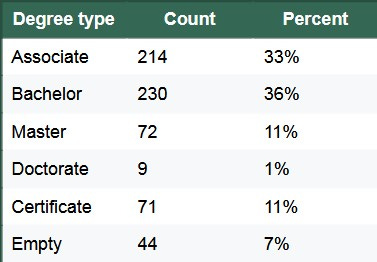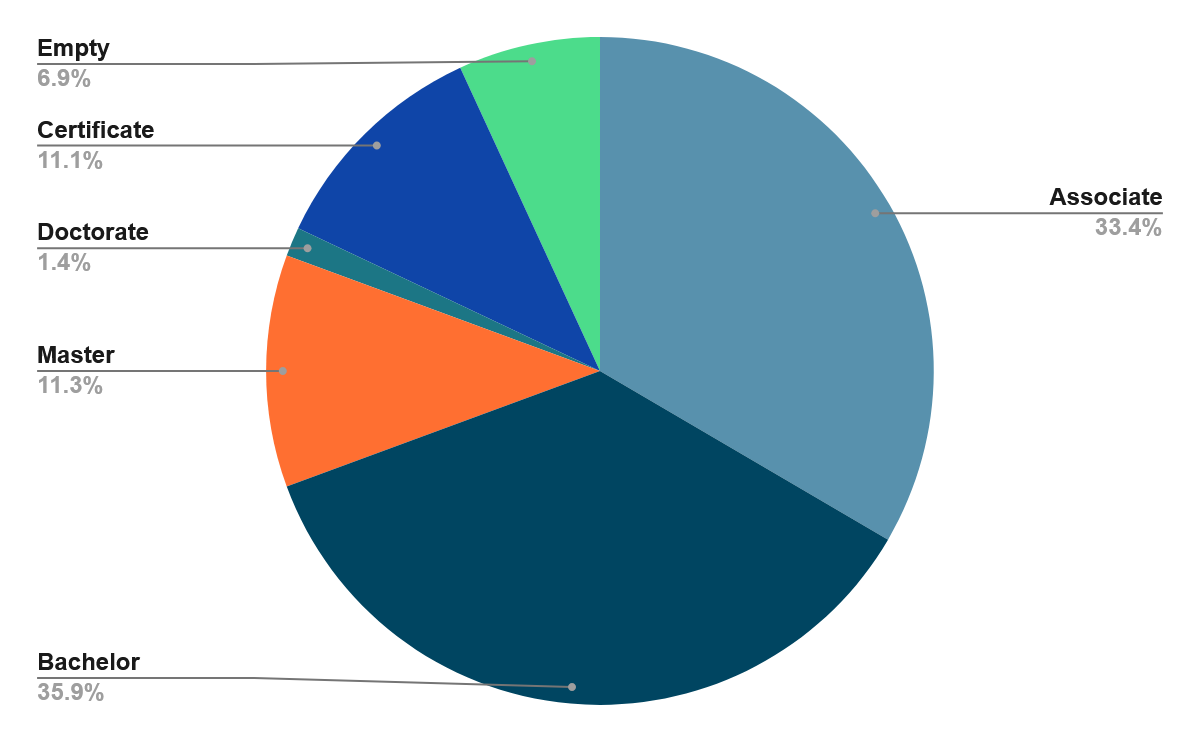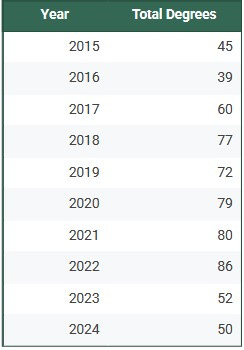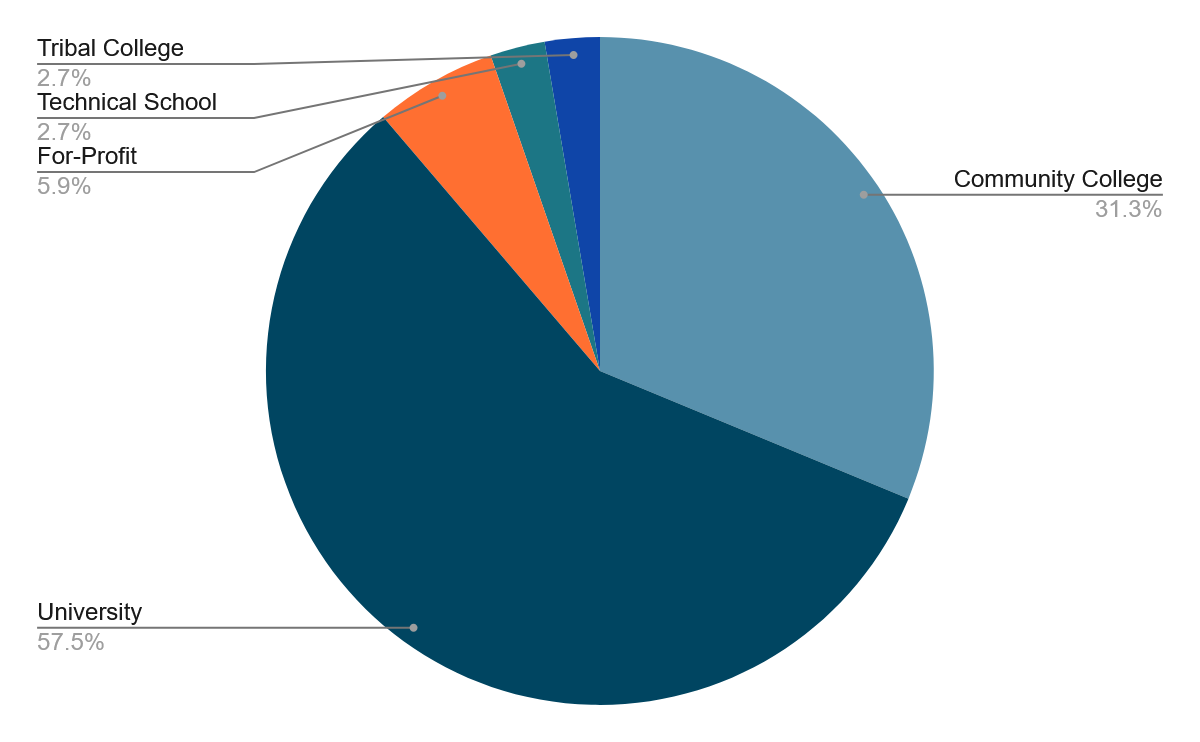A Decade of GRIC Higher Education Data (pt.2)
Data from Gila River Indian Community students from 2015 to 2024
In this article I’m going to be providing a summary of the data I’ve gathered from the Gila River Indian News about students who have been posted in the paper over the years. I’ll warn you that the data isn’t perfect, I’m going off a dataset that has changed a bunch of times over the past decade, but there is still a lot we can learn from it!
I have a copy of the de-identified data on my website if interested in exploring it yourself - there are gaps, especially in what specific degree field students completed, but without getting official data I think it is pretty great.
This is the first part - I’m breaking it in two parts to make sure it fits in emails easier!
Section 1: Executive Summary
This report provides a ten-year overview of higher education achievements by members of the Gila River Indian Community (GRIC), based on public recognition published in the Gila River Indian News (GRIN). It reflects the accomplishments of GRIC students who were acknowledged for earning degrees between 2015 and 2024.
Scope
Timeframe Covered: 2015 to 2024
Recognized Students: 589
Total Degrees Awarded: 640
Institutions Represented: 159 colleges, universities, tribal colleges, and technical schools
Degree Records Tracked: First, second, and third degrees where applicable
Degree Categories Used in Analysis:
Certificate
Associate
Bachelor
Master
Doctorate (PhD, EdD, etc.)
Section 2: Methodology
Data Source
This report is based solely on a manual analysis of student graduation announcements published in the Gila River Indian News (GRIN) from 2015 to 2024. Each year, GRIN publishes a “Congratulations Graduates” section that includes student data. Typically this includes names, institutions, degrees, and occasionally degree focus areas.
Data Preparation
Graduation entries were extracted from GRIN issues and organized into a structured dataset, including:
Anonymized student name
Institution attended
Graduation year(s)
Degree type(s)
Degree focus (when reported)
Institution type (e.g., university, community college)
Each student could have up to three degrees listed: Degree 1, Degree 2, and Degree 3. There were no students listed with more than 3 degrees.
Degree Classification Framework
To enable consistent comparison, all degrees were categorized into five standard types:
Certificate: Short-term or vocational programs (e.g., healthcare, trades)
Associate: Two-year degrees from community colleges or technical schools
Bachelor: Four-year undergraduate degrees
Master: Graduate degrees (MA, MS, MBA, etc.)
Doctorate: Terminal degrees (PhD, EdD, etc.)
Where the degree name was unclear, the category was inferred based on the institution and context.
Institution Type Assignment
Each school was classified into one of the following:
Community College
University
Tribal College
Technical School
For-Profit Institution
This classification was applied to a reference list of 159 institutions identified from the GRIN records. This classification was gathered from public websites for each school.
Handling of Missing or Incomplete Data
Not all GRIN entries included full information. To address this:
Missing degree types were inferred based on the school’s known offerings
Ie, Arizona State University typically will offer an Undergraduate degree, Central Arizona College typically offers an Associate degree.
HOWEVER, it is important to note that these institutions also occasionally offer certification…
Degree focus areas were included only when explicitly listed
A total of 87 first degrees and 15 second or third degrees were imputed using these methods.
Note: A significant portion of graduation announcements did not include a field of study. In this dataset, 266 of 642 degrees (42 percent) had no field reported. This limits the precision of field-specific analysis.
Section 3: Degree Completion Trends (2015–2024)
This section provides a year-by-year breakdown of degrees earned by GRIC students as publicly recognized in the Gila River Indian News.
*44 are blank or unclear in the data.
Insight
The dominance of bachelor’s and associate degrees reflects the continued importance of both 2-year and 4-year pathways in the Community. Community colleges serve as a vital entry point, while universities remain the main destination. However, the low share of graduate-level and doctoral degrees points to an opportunity to expand advanced education pipelines.
Section 4: Where Students Earn Their Degrees
GRIC students attended a wide range of higher education institutions between 2015 and 2024. This section explores the distribution of degrees by school type.
Institution Types Used
University: 4-year institutions offering bachelor’s and graduate degrees
Community College: 2-year public colleges, often serving as entry points
Tribal College: Native-led institutions rooted in cultural values
Technical School: Focused on certifications and vocational skills
For-Profit Institution: Private, tuition-based colleges offering career-oriented programs
Degrees by Year
Degrees By School Type
Insight
This distribution highlights the central role of universities in producing bachelor’s, master’s, and doctoral graduates, while community colleges remain critical for associate and certificate programs, as well as transfer pathways into 4-year institutions. The relatively small shares for tribal and technical schools suggest limited participation in culturally rooted or highly specialized vocational programs.
For-profit schools, while representing a modest portion of completions, tend to focus on career-oriented fields such as business, criminal justice, and allied health. These programs can meet workforce needs but may require careful oversight to ensure value and alignment with Community priorities. It is also important to note that some institutions — such as Grand Canyon University — have shifted between for-profit and non-profit status during this period, which can complicate retrospective analysis and comparisons.
The clear link between school type and degree level suggests that efforts to strengthen advanced education pipelines must begin by supporting early success in both community college and university environments, while also expanding culturally relevant and technical training options within or near the Community.







